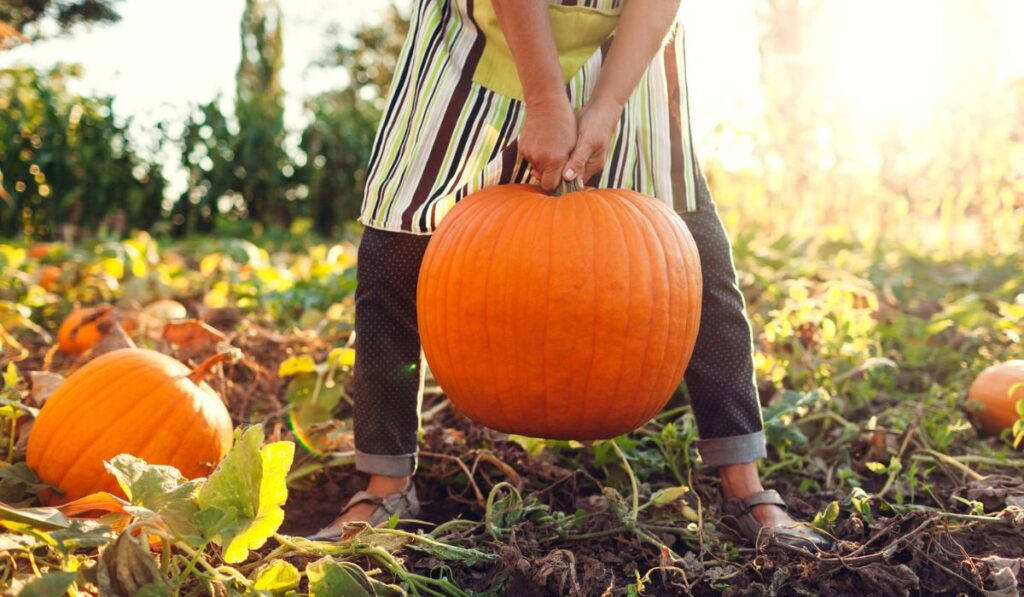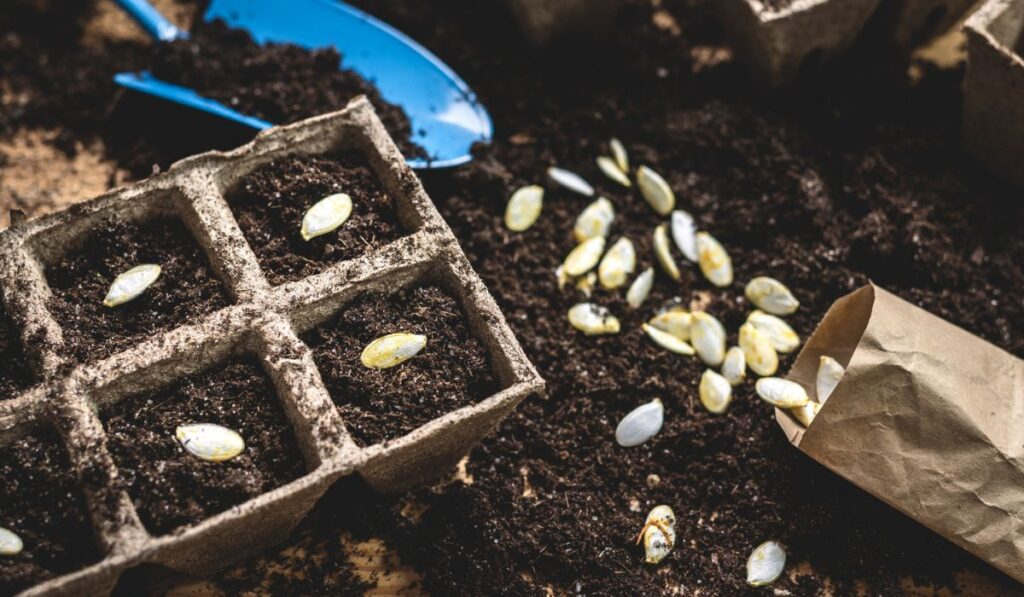Growing pumpkins in your garden could turn out to be just as easy as growing any other garden vegetables, given you have enough room and your garden gets sufficient sunlight. The following guide will walk you through planting and growing pumpkin seeds for a bumper harvest later in the year.
Prepare the pumpkin seeds and select the biggest ones because their chances of growth are high. Next, pick a planting site with soil that drains well and where your plants will get full light. Finally, sow your seeds in hills five feet apart to give the vines enough room as they’ll grow huge.
Whether you’re using them for cooking, carving, or decorations during Halloween, pumpkins don’t disappoint. So let’s jump into the details and learn how to plant, grow, care and harvest them in time for Halloween or that big dinner.
What are the Different Types of Pumpkins?
There are several pumpkin varieties grown worldwide, each one different in size, shape, and color. The end use primarily dictates what type of pumpkin you’ll grow in your garden. Some are best for making pies due to their thick, sweet flesh, while others are best for carving and roasting.
Here are the different types of pumpkins:
Miniature Pumpkins
They are very productive, easy to grow, and sometimes produce up to a dozen fruits per plant. They include:
- Jack be little
- We-Be-Little
Huge Pumpkins

They’re typically larger than most pumpkin varieties and have bigger vines. They include:
- Dill’s Atlantic Giant
- Big Max
- Big Moon
- Jack O’ Lantern
- Funny Face
Pumpkins for Carving
They usually have harder skin and a sturdy dark green hooked stem which you can use as a handle. They are:
- Autumn Gold
- Magic Lantern
- Merlin
Pumpkins for Pies
These pumpkins are excellent for cooking and baking. They have very sweet flesh, which can be great in pies and soups. They include:
- Sugar Treat
- Cinderella’s Carriage
- Peanut Pumpkin
Decorative Pumpkins
They are also known as ornamental pumpkins, and their primary purpose is to be a decorative display. They include:
- Jarrahdale
- Pepitas Pumpkin
- Super Moon
How to Plant Pumpkin Seeds
Here are easy-to-follow steps for planting pumpkin seeds:
Step 1: Prepare Your Pumpkin Seeds
If you’re planning on planting seeds that you got from a fresh pumpkin, you must prep them before planting them.
- First, clean off the pulp by placing the seeds in a colander and rinsing them with cold water.
- Next, separate them and select the biggest seeds from the bunch as their chances of growing and flowering are high.
- Lay them on a paper towel and allow them to air-dry. If you aren’t ready to plant them yet, you can store the seeds in an envelope and place them in your refrigerator.
If you decide to go for store-bought seeds instead, choose between these varieties: Autumn Gold if you want to grow pumpkins you can carve, Dill’s Atlantic Giant if you’re looking to grow pumpkins upwards of 200 pounds, or Casper if you want all-white pumpkins.
Step 2: Choose a Planting Site
Select a planting site where your plant will be receiving full sun. Be sure to confirm that the soil drains well because pumpkins grow better in soil that isn’t too soggy. Since pumpkins also need enough space to grow, you’ll need to clear a significant portion of your yard.
Purchase a kit and check your soil’s pH level as well. The kit should read between 6 and 6.8. Don’t forget to clear out any weeds, insects, and pests in the area. Applying a weed block two weeks before planting should do the trick. Alternatively, you could use an all-natural weed killer.
Step 3: Sow the Pumpkin Seeds in the Soil

Put the seeds in the ground properly when it’s time to do so. Pumpkins grow best when you plant the seeds about an inch deep into the soil.
Gardening gurus recommend planting the seeds in hills five feet apart because the vines grow large. However, if you’re planting a smaller variety of pumpkins, you may adjust the spacing to around three feet apart.
Once the plants germinate and the seedlings are about 2-3 inches tall, thin them so they’re only two or three plants per hill.
How to Care for Pumpkins
Pumpkins aren’t “stick the seeds in the ground and go” kind of plants. They require proper care due to their remarkable vine growth and massive size. They may call for some work, but the result is worth the effort. Here’s how to care for them:
Provide Them with Enough Sunlight
It would be best if you sowed the pumpkin seeds in a spot in your garden where the plants will get full sun for the better part of the day. They need at least 6-8 hours of sunlight daily. Sunlight is vital for photosynthesis and the growth process that develops them into the beautiful orange veggies we know.
Water Them Regularly
Your pumpkins need a lot of water when they are flowering and again after pollination when the gourds start developing. Try giving them at least an inch of water every week.
If the soil drains quickly or you live in a hot and dry climatic area, you may need to increase the amount of water slightly.
Add Fertilizers to the Soil
Due to their incredible vine growth and the size of gourds they develop, pumpkins are heavy nutrient feeders, meaning you’ll need to add fertilizers to the soil regularly.
They will gain a lot from continuous release fertilizer that you’ll have to apply every couple of weeks during the growing season.
Opt for high nitrogen in the early stages to promote foliage growth, then switch to a phosphorus-rich formulation as the plants start blooming.
Prevent Weed Growth
Like any other plant, pumpkins are susceptible to competition, so keeping weeds at bay is essential. Be careful when removing the weeds to avoid disturbing the pumpkins. You can also mulch to eliminate weeds and retain soil moisture.
Keep Pests Away
Some pests like squash bugs, cucumber beetles, squash vine borers, cutworms, aphids, leafminers, and thrips could go on a rampage in your garden and destroy your treasured pumpkins.
Your best defense is using herbicides and pesticides. However, if you don’t like using such chemicals on your plants, you could introduce companion plants like dill, marigolds, or oregano to naturally deter pests from your pumpkins.
When Should You Harvest Your Pumpkins?
You should always harvest pumpkins when they are fully mature. Any time before that, you’ll have soft, mushy pumpkins that won’t last very long. So, don’t pick pumpkins off the vine just because they have attained your desired size.
If you want small pumpkins, plant a small variety. Additionally, harvest on a dry day after the pumpkins have dried up and the skins are hard.
Tips to Help Your Pumpkins Grow
The following tips could help your pumpkins grow as big and healthy as they should:
Water Them Early in the Morning
Diligently watering the plant, preferably early in the morning, is crucial, especially in the summer, as the hot weather makes the vegetables extra dry. You can add mulch around the perimeter to help the pumpkins stay hydrated.
Prune the Vines
When the vines start showing, switch to a fertilizer rich in phosphorus. Once you’re ready to stop vine growth, cut off the fuzzy ends of the vine. Pruning the vine helps create space and focuses on blooming plant growth.
Prevent Pests and Diseases
Fend off any pests, insects, and weeds, especially during the early parts of the season. You may purchase some herbicides and insecticides to help combat them but use them carefully to avoid affecting your young plant.
